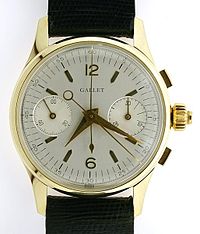- Double chronograph
-
 Double or Rattrapante Chronograph Wristwatch (1948) - manufactured by the Gallet Watch Company in La Chaux-de-Fonds, Switzerland.
Double or Rattrapante Chronograph Wristwatch (1948) - manufactured by the Gallet Watch Company in La Chaux-de-Fonds, Switzerland.
Double chronograph is a watch that includes two separate stopwatch mechanisms in order to estimate two separate events of different durations. It is often confused with the flyback chronograph.
Contents
Other names
- Rattrapante chronograph (French: rattraper - the act of recovering, recapturing)
- Split-second chronograph
- Split chronograph
Functioning
A watch with a double chronograph has two seconds hands. One hand is superimposed over the other. While one hand moves continuously, the other one can be either stopped, started or reset to zero.
The first push releases both hands. While one continues registering the time, the other hand can be repeatedly stopped. In order to stop and bring both hands to zero a watch has a return pusher. The position of the pusher, controlling the split-seconds function is usually at either 10 or 8 o'clock.
Brief history
The double chronograph was previously called Fly-back second. It was invented in 19th century by Adolphe Nicole. During the 1930s, due to a smaller size the mechanism was able to fit the case of a wristwatch.
In 1922 Patek Philippe launched into the market its first double chronograph. Today double chronographs (or rattrapante chronographs) can be divided into two subgroups. One comprises chronographs based on in-house movements of different watchmaking companies and the other group contains timepieces based on movements like the Valjoux 7750 from ETA.
The group of the in-house movements began with the Venus series of calibers: 179, 185, 189 and 190. These calibers had a rattrapante pusher on the crown but since 1952 they are no longer in production.
The first split-seconds mechanism based on the ETA-Valjoux 7750 was presented in 1992 at BaselWorld. Today this caliber is the main one used in watches with a split-seconds mechanism.
In 2010, Gallet introduced the first self-winding double chronograph movement powered by two separate mainsprings. The Swiss company's in-house manufactured calibre G330 solved the decade's old issue of decreased accuracy while utilizing the dual recording feature, a characteristic problem with double chronographs. Besides the longer duration (72 hours) between winds, this increase in available power enabled the G330 to maintain certified chronometer level accuracy across the full range of functions.
Bibliography
- Lang, Gerd R.; Meis, Reinhard (1993), Chronograph Wristwatches To Stop Time, Germany: Schiffer, ISBN 0-88740-502-9.
External links
Categories:- Watches
- Horology
Wikimedia Foundation. 2010.
